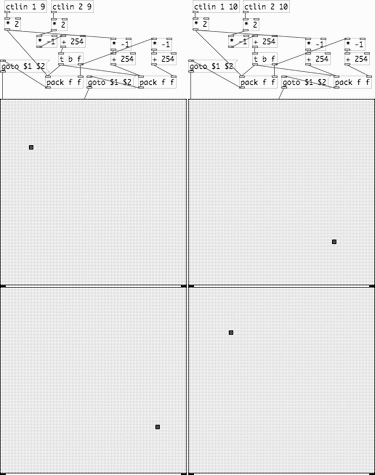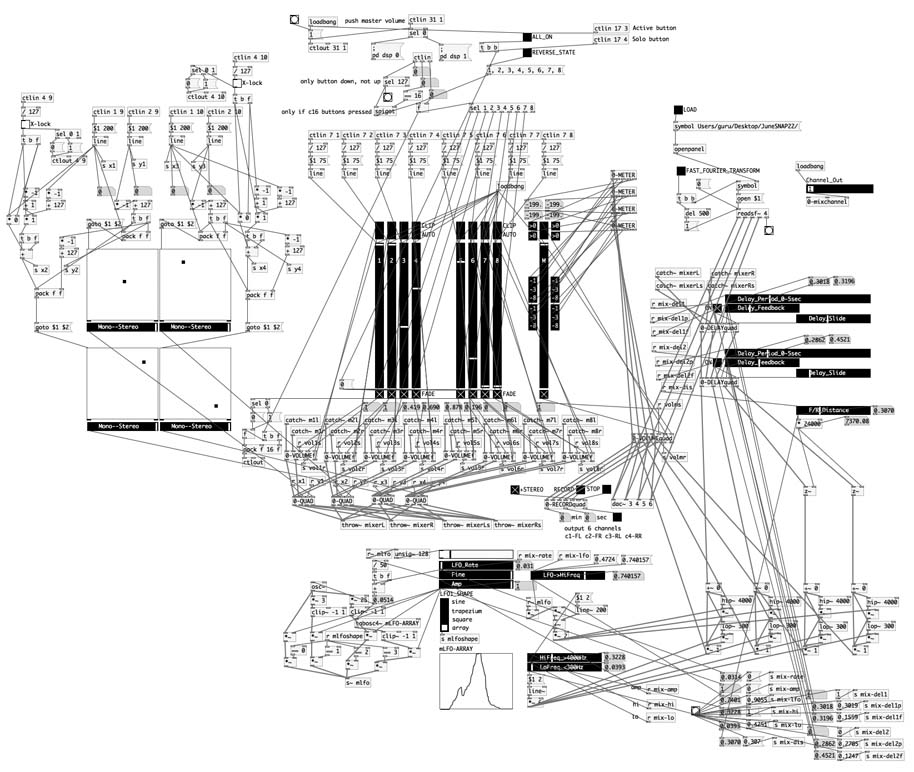SEE ALSO : EXTREME TIME STRETCHING
NUMBERSTREAM : 1. Developing methods of producing streams of continuous and complex 32-bit numerical fluctuations between -1 and +1; 2. assembling those streams into 2-channel ‘instruments’; 3. then playing iterations of those instruments live in a quadraphonic surround-sound environment.
BACKGROUND : NUMBERSTREAM instruments are built through structuring mathematical operations into data-flow-diagrams employing the graphical computer-based programming language Pure Data [PD]. Initially designed in the mid-1980’s for the Institute of Research and Coordination of Acoustics & Music [IRCAM] Paris, founded by the composer Pierre Boulez and is still in continual development by its original author Miller Puckette and the open-source community. PD is one of the foremost tools in sound experimentation utilised throughout the world in universities and audio research centres, and by musicians from classical, ambient, generative, techno, metal, to noise.
GENERATION : The mathematical generation of sound is almost instantaneous, yet vastly detailed. In order to work sculpturally within it, either this generation must be temporally extended – which is impractical in terms of working in real-time with a time-based medium, or it must be spatially extended – this is what you see here as NUMBERSTREAM instruments. Not only are they a spatial visualisation of an instrument’s interface, but more primarily they are a visualisation of the mathematical expressions that generate the basic numerical sources of an instrument’s vibrations. An analogy would be when making and then playing for instance a violin, the instrument-maker/musician is unusually also observing and manipulating the mathematic geometry of each strings’ chaotic movement, in a resolution of time far higher than generally perceived, and at a molecular level of detail. In fact one of the crafts of building these instruments is to hide the mathematical expressions, showing – just as a physical instrument – only the direct controls open to the musician; while I have mastered this approach, as both the musician and engineer I choose to show mostly everything: the inner nervous anatomy is readily available for modification.
FLOW-DIAGRAMS : These diagrams are visual paths for incredibly rapid and continuous streams of numbers to travel along, and in a similar manner to a river – always only in one direction. The majority of the work required to build an instrument is within this near instantaneous, silent domain of processing numbers in the scale between -1 and +1, rather than in physical audible movement. The source of the NUMBERSTREAM is around the top of each diagram, the stream then descends downward to leave that instrument to be mixed with others, and then eventually to be converted into electrical signals to control the back and forth -1 / +1 movement of a speaker’s diaphragm.
VARIABLES : Through the application of variables – generated by visual controls such as sliders, the numerical flow can be modified in the same way as interacting with a fretless or keyless physical instrument: the NUMBERSTREAM is played live, either in improvised compositions or following experimental scores. While these instruments can be directed to fit western scales, they are essentially free of any scale or tuning, and as such are not associated with the now ubiquitous notes of MIDI. This enables continuous note sliding for elevating glissandos and portamentos, but also discordant sound; part of the endeavour here is meeting the harmony of consonance with the freedom of dissonance.
INSTRUMENTS : I have developed three distinct types of stereo instruments: a string instrument, a dual wavetable instrument and a sonic microscope. In addition a quadraphonic panner/mixer, which through gesturally positioning a selection of up to eight discrete stereo instruments, across four speakers, can be viewed as a forth instrument in it’s own right.
7-STRING INSTRUMENT
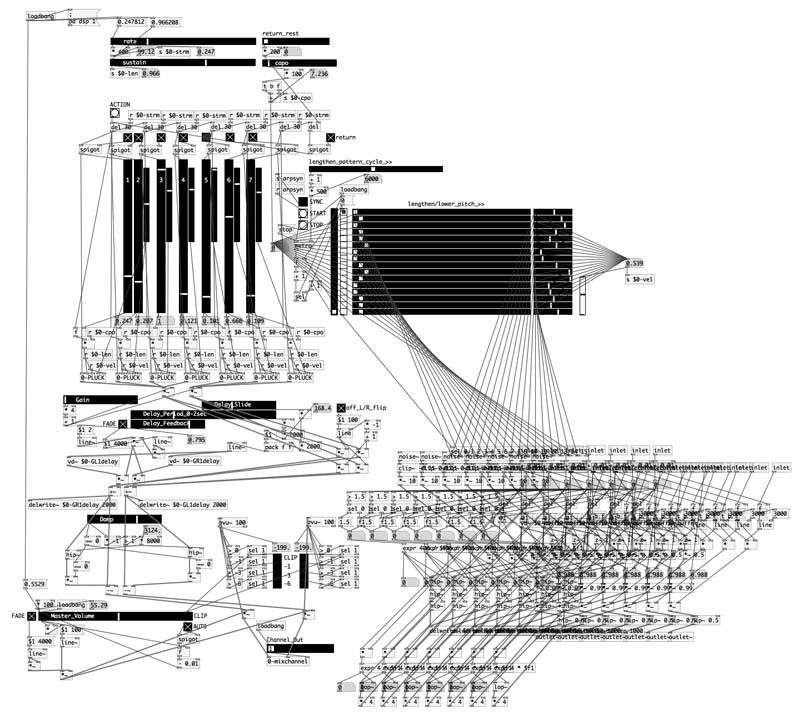
Here a wavetable [a custom pattern of oscillation] is captured from a very brief burst of 32-bit floating-point random numbers, or amplitudes, in the range -1 to +1; each random amplitude is generated at the chosen sample-rate, which at 48kHz is 48 thousand times a second. As this captured wavetable repeats [and so forms a frequency] it’s internal randomness is reduced with each cycle by fractional averaging of those sample-rate amplitudes. This sequential re-processing results in every ‘note’ following a similar trajectory, from random noise or hiss, to complex sine oscillation as the smoothing effect of averaging takes place, to the ultimate destiny for the average of any randomness – stillness or silence. Yet somewhat unusually for digital instruments each note of the same frequency has it’s own individual quality – as it is formed from a fresh capture of random numbers: every note of the same pitch is unique by the particular mix of it’s internal variations.
The rate at which the sequential re-processing occurs is controlled via sliding controls, modified in real-time either on-screen or with a physical controller to produce glissandos or portamentos. Similar in control to a fretless string instrument [which is open to potential discordance] it is not locked into a predefined scale as is a keyboard.
There are seven identical instances of this model which form the instrument here, these instances can be thought of as strings. Seven for a reason: I play the guitar [a six-string instrument] plucking arpeggios rather freely string by string, except for regular double-string plucking, two note chords. The seventh string in this NUMBERSTREAM instrument – in fact ‘string’ or slider 1+2, are always played as a two-string chord. This is the character of the instrument: clean single-string notes, rhythmically weighted by richer double-string chords.
There are several other playable controls to this event: the initial randomness can be restricted by a ceiling – mellowing the sound [woody as opposed to metallic]; the degree to which the note reflects within the instrument can be extended – effectively increasing the size of the instrument’s body or ‘sound-box’, so enabling the note to continue after it has come to rest or after it has been re-triggered with the same or a different frequency; vibrato – with variables as to rate, depth and if to continue after the note has been struck.
Tuning test | 12-string numberstream instrument; dense orchestral sautillé bowing, strings gradually tuned towards each other…
1:23 [tuning test] 12-String Instrument Tuning
The layered complexity when all seven strings are played almost simultaneously provides the depth heard in bowed instruments, and also an aggressive fever-pitch quality as the output of re-struck/re-bowed strings replaces their original vibration. The instrument’s body is also modelled, it’s resonance melds immediately previously bowed output with current; changing the body’s characteristics over time enables the instrument to move between metallic and woody timbres, and be part of the live control available to the musician.
16-STRING FFT INSTRUMENT
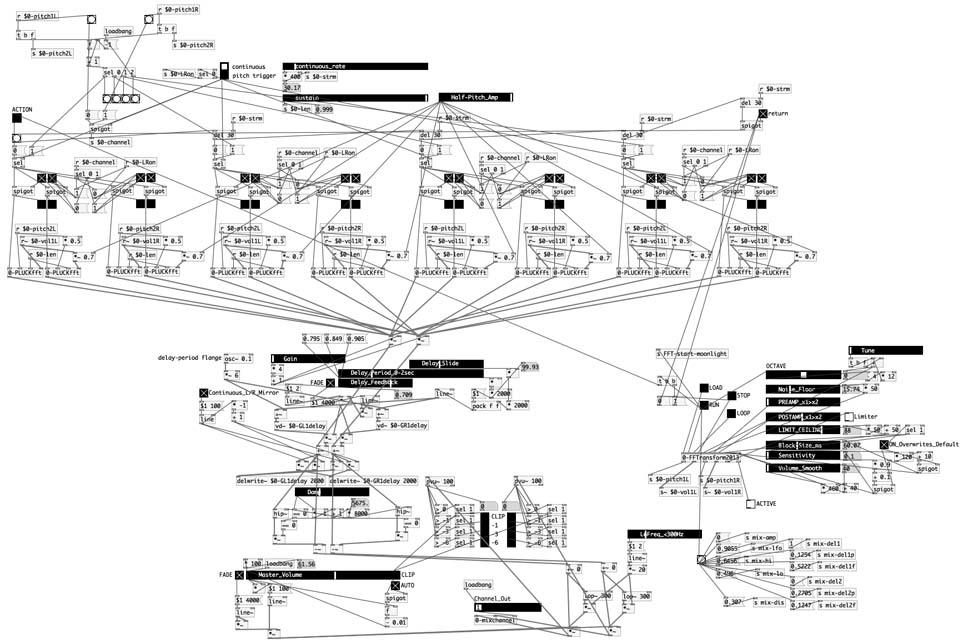
Frequencies entering the instrument originate from a Fast Fourier Transform [FFT] stream rather than manually controlled sliders.
FFT ‘listens’ to existing classical concert-hall recordings to provide a stream of frequencies and amplitudes for the instrument to play. In essence the FFT process re-scores an already recorded performance in real-time. This FFT score combines frequencies and amplitudes that may be originating from many instruments or even singers, into two closely related scores. Further scores for more NUMBERSTREAM instruments can be extracted by variously filtering the original performance.
In the same way as the 7-string instrument, it’s tonal characteristics can be modified in real-time as part of the performance.
DUAL MORPHING WAVETABLE INSTRUMENT
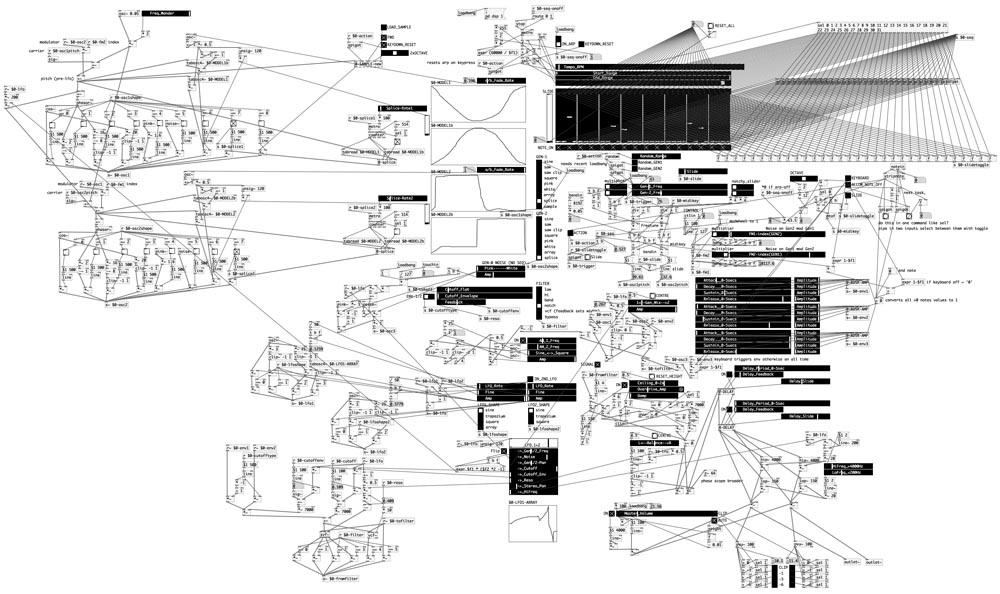
Four hand-drawn wavetables [upper centre].
With single-wavetable instruments [whether hand-drawn or loaded from a recorded .wav sample] the main oscillator is formed by cycling through successive iterations of the wavetable. With this dual-wavetable instrument emphasis is on slowly morphing between two wavetables to create a third waveform – which thence becomes the main oscillator. The moving spliced ‘edge’ within this third waveform has a swelling, sonic characteristic somewhat similar to a sweeping filter.
There are in fact two dual-wavetables here, both mixed into a single stream; this mix need not be static but can also be morphed between using a LFO wavetable [lower centre].
The morphing cycle within the dual-wavetables and the cycle between the two dual-wavetables, is not synchronised, so for as long as the note lasts there is a subtly non-repeating output.
SONIC MICROSCOPE
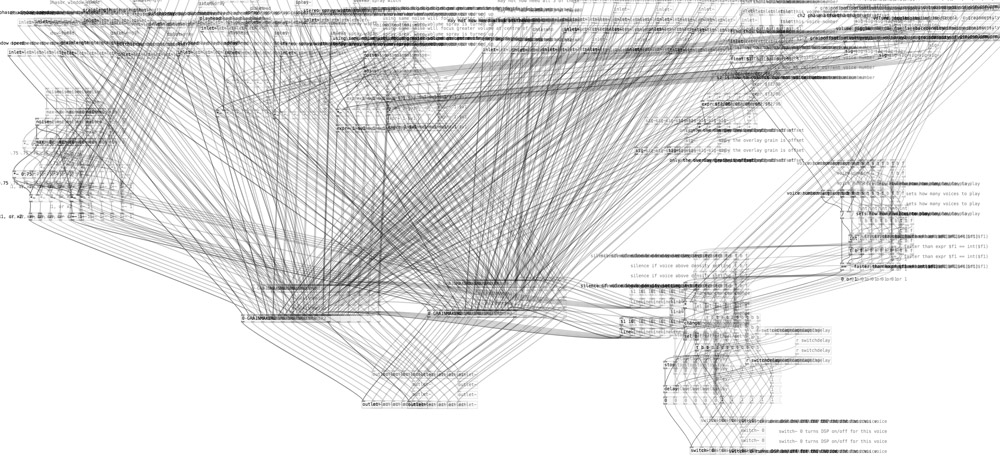
Development of a time-domain audio ‘microscope’. Field-recordings with events as brief as a second or less – to an unprecedented 1 millisecond, slowed by the order of 100 to 5000 times, revealing otherwise imperceptible temporal information.
This instrument has been optimised for 32bit audio exploration, critical inspection and on-the-fly processing of 48kHz, 96kHz and 192kHz stereo recordings, providing exact tailored manual controls of the parameters required for broadcast delivery. True textural resolution, experiential impact and tonal richness far exceeds other cutting-edge time-stretching methods such as those employing spectral FFT analysis.
With the ability to accurately define resolving qualities and the duration of the output, this ‘sonic microscope’ makes for an ideal partner in the interpretation of natural-world vocalisations through modest time-stretching, to the production of super slo-mo’ video through extreme stretching.
SEE FULL ARTICLE : EXTREME TIME STRETCHING
QUADRAPHONIC SURROUND-SOUND MIXER & SPATIALISER
The final stage of the NUMBERSTREAM when performing a live concert. Somewhat similar to a hardware mixer this has discrete control of 8 stereo channels / 16 input channels, though an infinite number of instruments can be played within this manifold of 8. These 8 stereo channels are then grouped into pairs from where as ‘4 locations’ they can be freely and actively distributed within a quad speaker environment.
Live performance control: positioning these 4 locations [each which can contain numerous instruments] within a space via two ALPS joysticks, utilising the now classic FaderFox LV3 Micromodule – shown below. Unlike positioning instruments or sections in an orchestra – which are static positions, here locations are able to move around the space in realtime with the direction of the conductor/musician. The primary innovation was made by Pink Floyd in 1967/69 with a single joystick [1 mono / 1 input channel] and then the dual joystick ‘Azimuth Coordinator’ [2 mono / 2 input channels]. Since then advances in quadraphonic joystick control have been neglected; a major part of the NUMBERSTREAM endevour is to reassert and develop quadraphonic spatialisation – and the experience of it!
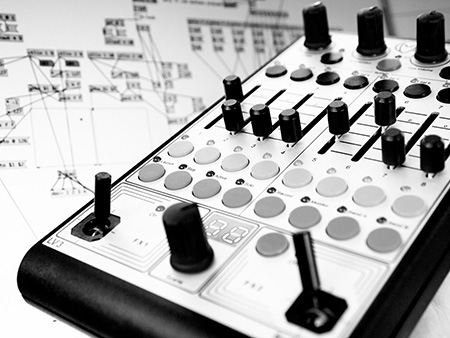
Locating an instrument in an extreme corner, reduces it’s stereo channels to either it’s left or right channel – depending on which side in the environment the instrument is being located. In this way, unlike a stereo to mono 50:50 mix, instruments sound different depending on which side of the environment they are located, lending the quad-spatialiser the ability to be an instrument in its own right. These quad locations are extremes, an instrument can be moved continuously and smoothly to any point within the space as part of the performance, in effect the instruments are able to take a journey within the space – which similarly encourages the listener to move around the installation.
I developed two further techniques to propagate instruments within the quad-field: one is concerned with repeatedly reflecting sound between the left and right sides of a space, enriching and elevating; the second is with, well bluntly – the speed of sound, travelling from the front source [speakers] to the rear. By increasing the singular time delay between delivering sounds to the front and back speakers the dimensions of the quad-field is extended, in essence providing the reality of a far greater room size than actual. Furthermore the separation of front to back delivery, enables the quad-spatialiser to add rhythm to an instrument’s notes through singular repetition, heard as double plucking.
